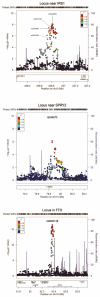Genetic variation near IRS1 associates with reduced adiposity and an impaired metabolic profile
- PMID: 21706003
- PMCID: PMC3262230
- DOI: 10.1038/ng.866
Genetic variation near IRS1 associates with reduced adiposity and an impaired metabolic profile
Abstract
Genome-wide association studies have identified 32 loci influencing body mass index, but this measure does not distinguish lean from fat mass. To identify adiposity loci, we meta-analyzed associations between ∼2.5 million SNPs and body fat percentage from 36,626 individuals and followed up the 14 most significant (P < 10(-6)) independent loci in 39,576 individuals. We confirmed a previously established adiposity locus in FTO (P = 3 × 10(-26)) and identified two new loci associated with body fat percentage, one near IRS1 (P = 4 × 10(-11)) and one near SPRY2 (P = 3 × 10(-8)). Both loci contain genes with potential links to adipocyte physiology. Notably, the body-fat-decreasing allele near IRS1 is associated with decreased IRS1 expression and with an impaired metabolic profile, including an increased visceral to subcutaneous fat ratio, insulin resistance, dyslipidemia, risk of diabetes and coronary artery disease and decreased adiponectin levels. Our findings provide new insights into adiposity and insulin resistance.
Figures



References
-
- World Health Organization . WHO Technical Report Series. Vol. 894. WHO; Geneva: 2004. Obesity: preventing and managing the global epidemic. Report of a WHO consultation on obesity. - PubMed
-
- Maes HH, Neale MC, Eaves LJ. Genetic and environmental factors in relative body weight and human adiposity. Behav Genet. 1997;27:325–51. - PubMed
Publication types
MeSH terms
Substances
Grants and funding
- R01 AG032098/AG/NIA NIH HHS/United States
- P30 DK063491/DK/NIDDK NIH HHS/United States
- R01 DK089256/DK/NIDDK NIH HHS/United States
- R01-AR046838/AR/NIAMS NIH HHS/United States
- R01-AG18728/AG/NIA NIH HHS/United States
- M01-RR00425/RR/NCRR NIH HHS/United States
- CZB/4/710/CSO_/Chief Scientist Office/United Kingdom
- N01 HC085086/HC/NHLBI NIH HHS/United States
- R01-HL088119/HL/NHLBI NIH HHS/United States
- K23 DK080145/DK/NIDDK NIH HHS/United States
- R01-DK07568102/DK/NIDDK NIH HHS/United States
- R01-AG031890-01/AG/NIA NIH HHS/United States
- RG/08/008/25291/BHF_/British Heart Foundation/United Kingdom
- R01 AR046838/AR/NIAMS NIH HHS/United States
- N01-HC15103/HC/NHLBI NIH HHS/United States
- N01 AG012100/AG/NIA NIH HHS/United States
- P30-DK072488/DK/NIDDK NIH HHS/United States
- R01 HL036310/HL/NHLBI NIH HHS/United States
- R01-HL08770003/HL/NHLBI NIH HHS/United States
- N01 CN015103/CA/NCI NIH HHS/United States
- G19/35/MRC_/Medical Research Council/United Kingdom
- N01 AG062101/AG/NIA NIH HHS/United States
- U01 HL080295/HL/NHLBI NIH HHS/United States
- N01-HC85079-86/HC/NHLBI NIH HHS/United States
- N01 HC075150/HC/NHLBI NIH HHS/United States
- SP/04/002/BHF_/British Heart Foundation/United Kingdom
- N02 HL064278/HL/NHLBI NIH HHS/United States
- G0100222/MRC_/Medical Research Council/United Kingdom
- U01-HL080295/HL/NHLBI NIH HHS/United States
- N01-HC55222/HC/NHLBI NIH HHS/United States
- MC_U127561128/MRC_/Medical Research Council/United Kingdom
- N01-HC75150/HC/NHLBI NIH HHS/United States
- G0700931/MRC_/Medical Research Council/United Kingdom
- N01 HC015103/HC/NHLBI NIH HHS/United States
- N01 HC025195/HC/NHLBI NIH HHS/United States
- AG13196/AG/NIA NIH HHS/United States
- DH_/Department of Health/United Kingdom
- R01 DK068336/DK/NIDDK NIH HHS/United States
- G0802051/MRC_/Medical Research Council/United Kingdom
- G8802774/MRC_/Medical Research Council/United Kingdom
- G1000143/MRC_/Medical Research Council/United Kingdom
- G0902037/MRC_/Medical Research Council/United Kingdom
- R01 HL087652/HL/NHLBI NIH HHS/United States
- SP/07/007/23671/BHF_/British Heart Foundation/United Kingdom
- R01 DK075787/DK/NIDDK NIH HHS/United States
- M01 RR 16500/RR/NCRR NIH HHS/United States
- N01 AG062106/AG/NIA NIH HHS/United States
- R01-DK075787/DK/NIDDK NIH HHS/United States
- R01 DK075681/DK/NIDDK NIH HHS/United States
- R01 AR041398/AR/NIAMS NIH HHS/United States
- R01-HL087652/HL/NHLBI NIH HHS/United States
- G0601966/MRC_/Medical Research Council/United Kingdom
- MC_U106179471/MRC_/Medical Research Council/United Kingdom
- R37 AG013196/AG/NIA NIH HHS/United States
- U01 HL084756/HL/NHLBI NIH HHS/United States
- R01-AG032098-01A1/AG/NIA NIH HHS/United States
- P30 DK072488/DK/NIDDK NIH HHS/United States
- R01-HL036310-20A2/HL/NHLBI NIH HHS/United States
- N01 HC055222/HL/NHLBI NIH HHS/United States
- N01 HC055222/HC/NHLBI NIH HHS/United States
- N01 AG062103/AG/NIA NIH HHS/United States
- G0401527/MRC_/Medical Research Council/United Kingdom
- RG/08/008/BHF_/British Heart Foundation/United Kingdom
- R01-DK06833603/DK/NIDDK NIH HHS/United States
- N01-HC45133/HC/NHLBI NIH HHS/United States
- G0701863/MRC_/Medical Research Council/United Kingdom
- 077016/Z/05/Z/WT_/Wellcome Trust/United Kingdom
- MC_PC_U127561128/MRC_/Medical Research Council/United Kingdom
- U01 HL072515/HL/NHLBI NIH HHS/United States
- G20234/BB_/Biotechnology and Biological Sciences Research Council/United Kingdom
- M01 RR016500/RR/NCRR NIH HHS/United States
- R01-AR/AG41398/AG/NIA NIH HHS/United States
- 095515/WT_/Wellcome Trust/United Kingdom
- G0600717/MRC_/Medical Research Council/United Kingdom
- U01-HL84756/HL/NHLBI NIH HHS/United States
- M01 RR000425/RR/NCRR NIH HHS/United States
- R01 AG013196/AG/NIA NIH HHS/United States
- DK063491/DK/NIDDK NIH HHS/United States
- N01-HC25195/HC/NHLBI NIH HHS/United States
- N01 HC085079/HC/NHLBI NIH HHS/United States
- R01 HL117078/HL/NHLBI NIH HHS/United States
- MC_U106188470/MRC_/Medical Research Council/United Kingdom
- N01 HC045133/HC/NHLBI NIH HHS/United States
- 091746/Z/10/Z/WT_/Wellcome Trust/United Kingdom
- R01 HL087700/HL/NHLBI NIH HHS/United States
- 091551/WT_/Wellcome Trust/United Kingdom
- 084723/Z/08/Z/WT_/Wellcome Trust/United Kingdom
- R01 AG018728/AG/NIA NIH HHS/United States
- N01 HC035129/HC/NHLBI NIH HHS/United States
- U01-HL72515/HL/NHLBI NIH HHS/United States
- R01 AG031890/AG/NIA NIH HHS/United States
- PG/07/133/24260/BHF_/British Heart Foundation/United Kingdom
- CRUK_/Cancer Research UK/United Kingdom
- K23-DK080145/DK/NIDDK NIH HHS/United States
- N01-HC35129/HC/NHLBI NIH HHS/United States
- N01-AG12100/AG/NIA NIH HHS/United States
- R01 HL088119/HL/NHLBI NIH HHS/United States
- RG/07/008/23674/BHF_/British Heart Foundation/United Kingdom

